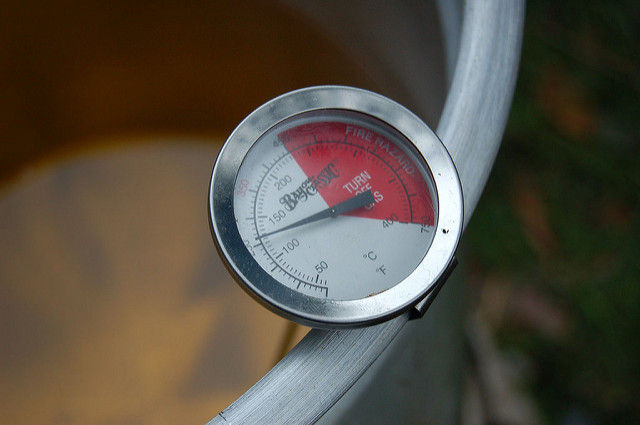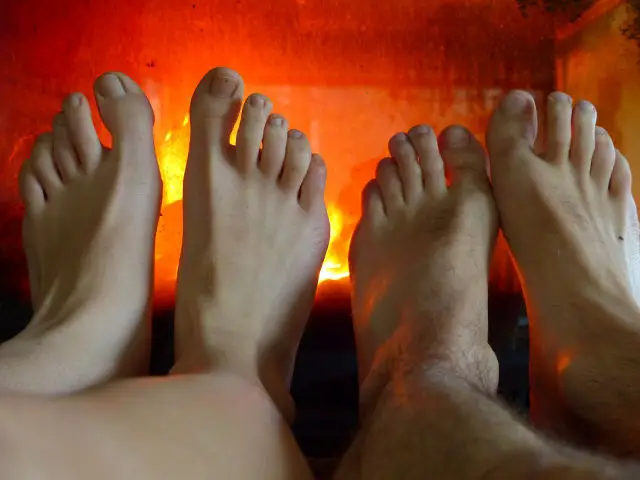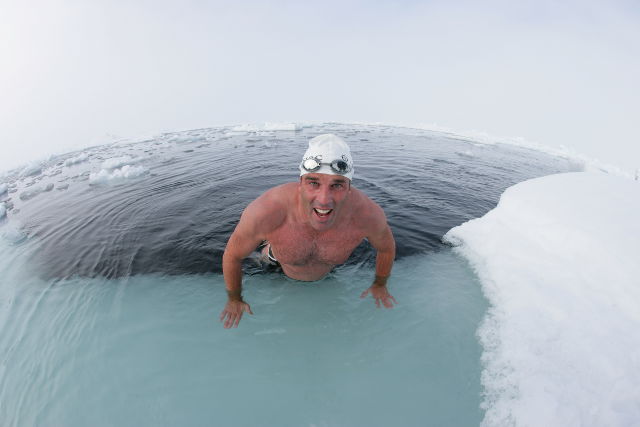Jonathan Dodd’s latest column. Guest opinion articles do not necessarily reflect the views of the publication. Ed
There are twenty people in my office. Not all of us are there all the time, and we’re a mixed bunch, ranging from old codgers like me to frighteningly young and brilliant aliens who look like teenagers and talk unintelligibly. They explain things to me with great patience. We all get on really rather well for such a diverse group, in all areas except one.
I long ago realised that the human race is composed of two separate groups of beings. Hot Humans and Cold Humans. They’re either constantly cold or constantly hot. You can tell the difference between them easily. Observe on the one hand the thickness and number of layers of clothing, the wrapping of arms around oneself, and the constant shivering because it’s always cold.
Opening doors can be a risky business
Then, sitting usually at the next desk, you will see someone taking layers of clothes off, looking longingly at windows and air-con machines, because they’re dying of excessive heat in the same room as those who are freezing and who howl as soon as they notice the slightest draft. Opening doors for more than a second or two can be a risky business.

The interesting thing about this is that there’s actually no difference in the ambient temperature surrounding both of these humans, and if you took their temperatures or measured the surface of their skin, you’d probably find little difference there. Whatever is happening, it’s all inside, in mind or in body, or both. This has always been a mystery to me.
Handed out randomly at conception or birth
It’s not even genetic. Most of us can point to members of our own families who belong to both groups. I’ve had direct experience of it myself. It’s not inherited down the generations, as far as I can see, and it doesn’t follow patterns between parents and children or amongst siblings. I do admit that my research is patchy, and not in any way representative or scientific.

I’ve always felt that certain items in our human toolbox are handed out randomly at conception or birth. We have inherent skills and abilities, both physical and intellectual. I think we can all agree to that. I’m convinced I was never going to be David Beckham or Albert Einstein, even with intense training from a very early age. I can’t ‘see’ things in my memory or my imagination. I never could, and I still can’t, because my mind isn’t wired that way. Most people’s minds work visually. These things make us different in fundamental and mysterious ways.
Different thresholds for different kinds of pain
I also know that some people have different pain thresholds, and we have different thresholds for different kinds of pain. I can understand that cultural differences can make a difference here too, but it’s easier to maintain a stiff upper lip if you’re fairly immune to pain rather than a sensitive type. Some people can remain dignified and brave with a broken leg, but they might still faint at the sight of a hypodermic needle.

I understand phobias and other kinds of learned behaviour. We can learn good or bad reactions to things that happen to us, and then reinforce those reactions through repetition, and we can think we’re just like that, although these things can easily be unlearned. I’m not talking about things that are based on behaviour here. We have all sorts of internal settings within the complex systems that we call our bodies, and somehow these get set in different ways. There isn’t a universal common settings template for human beings, it seems. And we don’t have a factory settings reset button either. At least I haven’t found one yet.
We don’t behave like the machines we make for ourselves
Even those who believe that we’re just machines have to accept that we don’t behave like the machines we make for ourselves. We’re so-called ‘intelligent’ machines, as if the owner and the machine have been integrated wholly, so they’re indistinguishable from each other. But there’s no manual, and no instructions. Even worse, we appear to have no purpose. That’s a question none of us have completely got our heads round yet.

The Hot and the Cold are people whose internal settings are different. These settings are rather like gauges that you might find on a wall in a factory or control room. What’s the gas pressure? What’s the temperature in the vat? Look at the needle on the dial. If it’s above 15 and below 45 it’s fine. Below 15 you need to put some more fuel in maybe. Anything above 45 is red, and you need to do something drastic before it blows up. There may be a klaxon or flashing lights to make sure you notice.
A fire alarm that doesn’t work
Gauges are useful and important. You want to know if your car engine is running out of oil, or the core of your nuclear power station is getting too hot. But gauges that we install need to be checked all the time to make sure they’re accurate. They may break, or wear out, and then they’re not just useless, they’re dangerous. We all have fire drills at work, so we know what to do when the fire bells ring. A fire alarm that doesn’t work is as terrible as a broken promise, and there’s not much that’s more irresponsible than failing to maintain them.

Our own internal gauges don’t seem to work in this way though. They seem to be set to random levels, and we either accept that the way they work is how they’re meant to work, or we don’t know how to recalibrate them. In the case of the Cold person and the Hot person sitting next to each other in the office, they both have nerve cells embedded in their skin that relay external temperature data to their brains, but they also have internal temperature gauges.
The warm-footed person feels colder inside
I think the data that the Cold person’s skin transmits is most likely the same data sent by the Hot person’s skin. The difference seems to be how the data is interpreted by their brains. I know that I can be sitting comfortably on my sofa, but someone touching my hands or feet can be surprised how cold they feel to the touch. At these moments I’m often asked to compare the touch of their hands or feet with mine, and they do feel warmer. But the warm-footed person feels colder inside than I do, even though I have cold feet.

It’s a mystery. We use the same words for a variety of things. When I ‘feel’ warm, I’m describing the level of comfort I feel internally. This appears to have little relevance to the temperature of my outside skin. If I ‘feel’ something with my hand and notice that it’s hot or cold, that’s a completely different thing. I’m judging the temperature of an external object using the nerve cells embedded in the skin on my hands. But whether I ‘feel’ hot or not is a matter of how warm the inside of my body feels.
Parts of us are constantly transmitting data to our brains
No wonder we mix it all up. It’s like sitting in a car on a cold day. The temperature outside is near freezing, but we’ve got the heater on full blast. Is it hot, or is it cold? Anyone sitting in the car will feel warm and safe, but someone outside will notice how cold the metal is. If I’m in that car I’ll be taking my jacket off, because I’ll feel warm. The person next to me will probably look at me incredulously. Am I feeling hot because the inside of the car is hot, or are they feeling cold because it’s cold outside? It’s a mystery.

We have a lot of systems like this. Parts of us are constantly transmitting data to our brains, most of the time they’re saying everything is all right. Or it’s your stomach saying it’s digesting, or empty. Or your bladder saying it’s full or empty. The floor is hard, your elbow is healing after a blow, there’s an itch behind our knee that needs scratching. A light wind is blowing, the wall is rough, it’s time to find some water to drink, or some sugar. Or your heart isn’t beating so well.
They’ve injured themselves a lot but it has never hurt
When something goes wrong we need to know quickly, so we can take remedial action. It’s up to us to notice and interpret these signals intelligently. If there were no signals, our lives would be short. Very rarely, someone is born with no nerves in their skin, or nerves that don’t function in some way. These people don’t ‘feel’ anything. No hot or cold, no pain. Their hand could be on fire and they wouldn’t notice until they smelled burning, and they break a lot of bones – they’ve never learned to be careful because they’ve injured themselves a lot but it has never hurt.

I’m very grateful for all these systems. I don’t understand how most of them work. I also don’t understand why or how they seem to work differently for different people. I’m not at all sure that the settings we have are fixed for ever. I’ve known people who have gone to live in warmer countries. After a year or two they start feeling cold in the autumn there, which is like our summer. They become acclimatised. I’ve known people who have learned to live with pain, or have worked out a way to overcome their reactions to the messages their bodies are sending them.
We can have much more control over them than we think
For instance, the marathon runner who recognises the pain and runs through it. When we understand that our stomach is just telling us it’s empty, not that we’re starving. Feeling the difference between anticipation and fear. Trusting that a pain might need a visit to the doctor, rather than putting it off until it’s too late. All these systems are giving us good information. I think we can have much more control over them than we think.

Meanwhile, I’m wondering if anyone will notice if I turn the thermostat down. Just a bit.
If you have been, thank you for reading this.
Image: Lewispugh under CC BY 2.0
Image: willsisti under CC BY 2.0
Image: Public Domain
Image: alexas fotos under CC BY 2.0
Image: ukanda under CC BY 2.0
Image: Albert Bridge under CC BY 2.0
Image: hans under CC BY 2.0
Image: Steag, Germany under CC BY 2.0
Image: Pchemstud under CC BY 2.0
Image: starmanseries under CC BY 2.0





